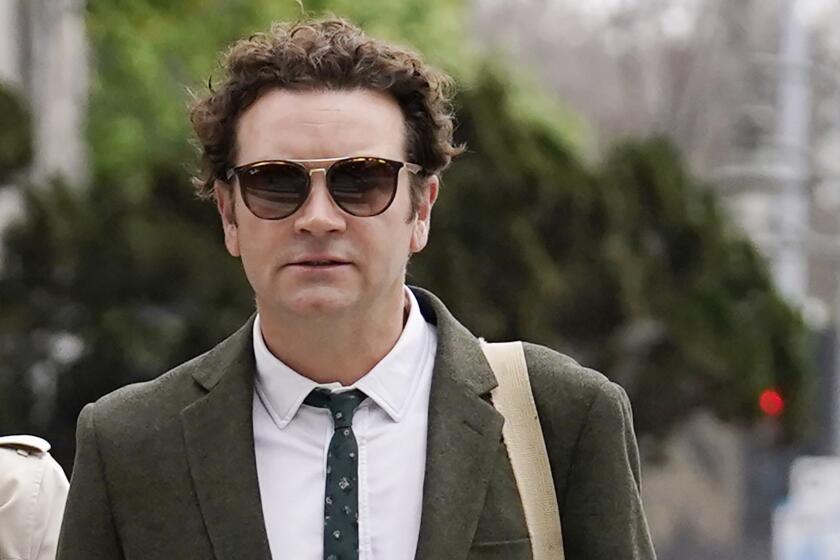Babies, Off to a Perilous Start, Find the Help They Need From Foster Parents
Life cheated Javier even before he was born.
The brown-eyed infant, premature by 10 weeks, was the victim of his motherâs life style. He was born with an addiction to heroin and is afflicted with syphilis. Because Javier suffers from a respiratory disorder called apnea, he must be constantly hooked to a respirator and monitored by a machine that detects oxygen deficiency.
Javierâs 18-year-old mother--a former foster child herself--cannot properly care for him.
But there is a fighting chance that babies like Javier (not his real name) can survive, in part because of a dedicated group of foster parents who care for âhigh-riskâ infants: those who must be monitored 24 hours a day.
âYou just never know what to expect next with these children,â said Eva Marmont of Brea, who along with other foster parents is pushing for help to better care for these high-risk, neglected infants.
Tim Healey, a child development specialist at Childrens Hospital of Orange County who has done extensive studies on apnea and drug-addicted infants, said he is overwhelmed by the dedication of foster parents.
âThey bring me back to reality,â he said. âThey go way beyond what has to be done. They deserve the credit. They are providing these infants with an opportunity to reach their optimum (developmental) potential.â
Jan Allen of San Juan Capistrano, Javierâs foster mother, has nursed the baby through ordeal after ordeal for the last six months. Eight-month-old Javier, like all infants born drug-addicted, cannot handle stress. Every little noise or movement seems to bother him.
âDrug-addicted babies are just not consolable when they start crying,â Healey told a group of foster parents at a recent workshop.
Until very recently, Javier never slept more than three hours at time. Allen recalled rushing to him when his oxygen monitor shrieked in the middle of the night.
âHe really keeps me on pins and needles,â she said.
Healey, who has followed between 200 and 300 apnea and drug-addicted infants during the last six years, said doctors and therapists are becoming more sophisticated in identifying the high-risk babies at birth.
First 9 Months Critical
âWeâre not just looking at the neurological makeup, but the behavior patterns as well. There is more sensitivity now to the conditions of the infants,â he said.
Healey credits the increase in seminar type discussions as an effective tool to teach both biological and foster parents the proper care of high-risk infants. He said the first nine months of life are the most critical since infants go through âthe most changes during that period.
âThe incidence of learning disabilities are great with these children if they are not treated well before 9 months of age,â he said.
At a recent seminar on the proper care of apnea high-risk infants, Healey demonstrated for about 25 foster parents and social workers how subtle ways of holding a baby can enhance normal development.
Holding a 3-month baby born cocaine-addicted, Healey showed how the infant would stiffen its tiny feet or arch its back, typical idiosyncrasies of high-risk babies. When the baby began to cry, Healey turned her face up, away from him, and placed his hand on the childâs chest, a position called âswaddling.â
Within 20 seconds, the baby quit crying.
Proper Handling
Normal infants are usually cradled or laid on their backs, but high-risk babies placed in those positions are only stimulated in what Healey calls âa sympathetic state,â a condition that prompts babies with a low stress threshold to squirm and cry.
âChildren who are low threshold have very immature (nervous) systems. They can become uncontrolable and inconsolable when they start crying,â Healey said.
Although county officials have only recently begun to document the number of apnea and drug-addicted newborns, there appears to be a sharp increase in the birth of this type of infant.
William G. Steiner, the outgoing director of the Orangewood Childrenâs Home in Orange, said that in the last six months of 1985, the shelter took in 51 newborn, drug-addicted babies. That represented 37% of babies admitted to the shelter during that period.
âThose babies automatically come under protective custody,â Steiner said.
The more afflicted infants cannot be cared for at Orangewood, and they either must remain in the hospital or go directly to long-term care in a private foster home. Steiner said that high-risk apnea children cost the county between $350 and $1,000 a day while they are in the hospital.
Overburdened System
The difficulty of caring for these infants, Steiner said, puts additional strain on an already overburdened foster care system.
âThese infants are so difficult to parent. And it is (another) factor for parents to abuse the child, or a factor for the foster parents to return the child,â he added.
Currently, there are about 100 apnea and/or drug-addicted infants under private foster care in Orange County. About a dozen are so severely afflicted that they must be constantly hooked up to the oxygen monitor.
One of those oxygen-monitored infants is Joey (not his real name), a 6-month-old baby Eva Marmont has looked after for the past four months. Although he appears alert, Joey is very fragile and looks to be only about half his real age.
For Marmont, she sees her care of Joey as simply a way of giving him a chance at real survival.
âThese babies need very special care,â she said. âWe have such a high proportion of high-risk infants that we need to place them in a good home just to prevent further physical problems.â
Guidelines for Care
Marmont and Allen also have been instrumental in forming a committee of foster parents who care for high-risk apnea children. The committee has proposed guidelines for care that the county Social Services Agency will probably adopt.
The guidelines are designed to insure that the high-risk infant is afforded the best possible care while under the foster care program and that the foster parent is given the proper support to meet the needs of the baby.
âWe canât rely on each other so much. We are trying to integrate a child like this into already hectic lives like some of us have. We need the support,â Marmont said.
Because therapists like Healey feel that the 4-month, 9-month and 2-year-old stages are very critical in the development of the high-risk infant, efforts are being made to keep the child in a stable, caring private foster home. Too many times a biological parent prematurely regains custody of the child and the development is stunted, he said.
âWe want children back with the family, but not at the expense of the baby,â Healey said. âThese babies need a lot of special care and thatâs why we try to spend so much time teaching proper care.â
Experience for Teaching
Healey also would like to see more foster parents who have become adept at caring for apnea high-risk infants begin to teach potential foster parents their methods. He said foster parents âinnatelyâ take to the doctrines he teaches them.
âWeâd like to see more foster parents take over some of the teaching because they really are the ones who have seen the improvement these babies make,â he said.
It is real improvement that gives hope to people like Allen and Marmont that their efforts can save lives. Allen, who began a nursing career 15 years ago, has finally realized that babies who once had no opportunity for survival now have a fighting chance.
Javier, the child she cares for, now has a fair chance for a normal life. He does not squirm as much from his drug addiction, and his syphilis is under control. In time, with more special care and more development, he should be able to discard the apnea monitor.
âKids (such as those) we were taking to the morgue when I was a candy striper are now being saved,â she said.
Healey and Allen said that hospital personnel need more sophistication, and training, in identifying apnea and drug-addicted infants at birth.
âFor a long time, no one knew they (high-risk infants) were around,â Allen said. âNow they can be identified better. Itâs not the kids on the monitors who are dying. The ones not picked up (at birth) are the real time bombs.â
More to Read
Sign up for Essential California
The most important California stories and recommendations in your inbox every morning.
You may occasionally receive promotional content from the Los Angeles Times.










